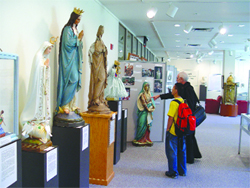Welcoming Immigrants
With a rich ethnic heritage established through influxes of people from throughout the world, the Archdiocese of Newark is a microcosm of the universal Church. The people who represent the Church of Newark are an ever-changing kaleidoscope.
Long before the coming of the Europeans and Christianity, the first inhabitants were the Lenape. Their world disappeared as one nation after another settled in what would become New Jersey.

In 1524, the first European to sight these shores was Giovanni da Verrazano, an Italian sailing for the French, who was eventually executed by the Spanish. From this first sighting, almost 500 years ago, this region developed a multi-ethnic character.
The first Catholics to settle in New Jersey, as best as can be determined, came in the latter part of the 17th century. They encountered a land where the Dutch, Swedish, English and other European cultures intermingled with one another and with Native Americans.
The first Catholic to leave an imprint was William Douglas from Bergen (present-day Jersey City), who was elected to the colonial assembly in 1680. Early in the 18th century, a small mission was established near Salem, and was served by the first recorded missionary, Rev. Theodore Schneider, S.J., who arrived in 1744.
In 1789, New Jersey Catholics received their first bishop when John Carroll was named Bishop of Baltimore, a diocese that stretched from Maine to Georgia, from the Atlantic to the Mississippi River. Almost 20 years later, New Jersey was divided between the newly established dioceses of New York and Philadelphia.
In 1814, the first Catholic church, St. John’s, was built in Trenton. The first church to be built in Newark was similarly named St. John’s, opened in 1828. The congregation of St. John’s, Newark was predominately Irish. St. Mary’s opened in 1842 to serve the German community. The Irish and German Catholic presence would rapidly multiply as immigrants fled the Great Famine of 1845-50 in Ireland and the aftermath of revolutions in the German states during 1848.
In the next half-century, dozens of parishes would sprout up to serve this first great wave of immigrants. Religious and cultural societies, within and across parishes, would express the national and religious character of these communities. Societies including Holy Name, Rosary, Altar, St. Vincent dePaul and Children of Mary were in every parish. Organizations such as the Ancient Order of Hibernians, and social and athletic Vereins brought large number of Irish and German men and women together across parish boundaries. Parades and parish feasts were commonplace. These activities set a pattern that each new ethnic group would follow in their own distinct manner.
In the late 19th century, wars, revolutions and economic crises would bring Catholics to New Jersey from southern and eastern Europe as well.
The greatest number came from Italy and dismembered geo-politically Poland. Lithuanians, Czechs, Slovaks, Hungarians, Slovenians, Croatians and Ukrainians came from the Russian and Austro-Hungarian Empires. The immigration continued until World War I when the restrictive immigration laws of the 1920s closed the door. At the same time, smaller numbers of Spanish and Portuguese Catholics arrived primarily from the Canaries and the Azores. The beginning of the great internal migration of African Americans added to the small community of black Catholics.
From the 1920s until after World War II, the Church of Newark continued to serve all those whom it had welcomed over its first century. In the last 50 years, the cycle was repeated, resulting in a Church that is not only multi-ethnic, but multi-racial, representing all the continents of the world.
In the 1950s, fellow citizens from Puerto Rico came to the Archdiocese, soon followed by the great Cuban migration of the 1960s. Dominicans, Colombians, Mexicans, and Catholics from all of Latin America would, over the next 50 years, make Newark a diocese with one of the largest Latino populations in the United States. Also, immigrants from South America continue to move to the Archdiocese especially, thousands of Brazilians who make their home in many parishes of Union, Essex and Bergen counties.
The immigration reform acts of 1965 and the following years opened the doors to the rest of the world. Catholics from the Philippines, Vietnam, Korea, China, India (Indian Catholics of Syro-Malabar and Syro-Malankara rites using Malayalam language in the liturgy), and many other nations made the diversity that is Asia a vital aspect of the Church of Newark.
Africa, whose descendents had long been a part of the Newark-area community, soon gave the local Church Catholics from Nigeria, Kenya, Uganda, Cameroon, Zambia, Congo and other African countries.
From the Caribbean came Haitians and Jamaicans, and people from a myriad of islands. The Middle East, the cradle of the faith, added Catholics from Egypt, Palestine, Lebanon, Syria, and elsewhere.
Simultaneously, Catholics from Europe continued to arrive, in particular, from Portugal and from central and eastern Europe.
Today, on a given Sunday, Mass is celebrated throughout the Archdiocese in dozens of languages. There are parishes that are predominately “Euro-American,” Filipino, Latino or Korean. Other parishes are bi-cultural, serving perhaps a Latino and Haitian population. There are some that serve three or more distinct cultural groups. Many serve all comers.
The Catholic people of the Archdiocese of Newark are urban and suburban, 12th and first generation Americans, “green card” holders awaiting citizenship, or recent arrivals waiting for their “papers.”
All bring their unique spirituality, their unique love for the faith, their Catholic presence.
BY MSGR. ROBERT J WISTER, Hist. Eccl. D.
Special to The Catholic Advocate
Reprinted form The Catholic Advocate, Official Commemorative Edition, October 15, 2003
